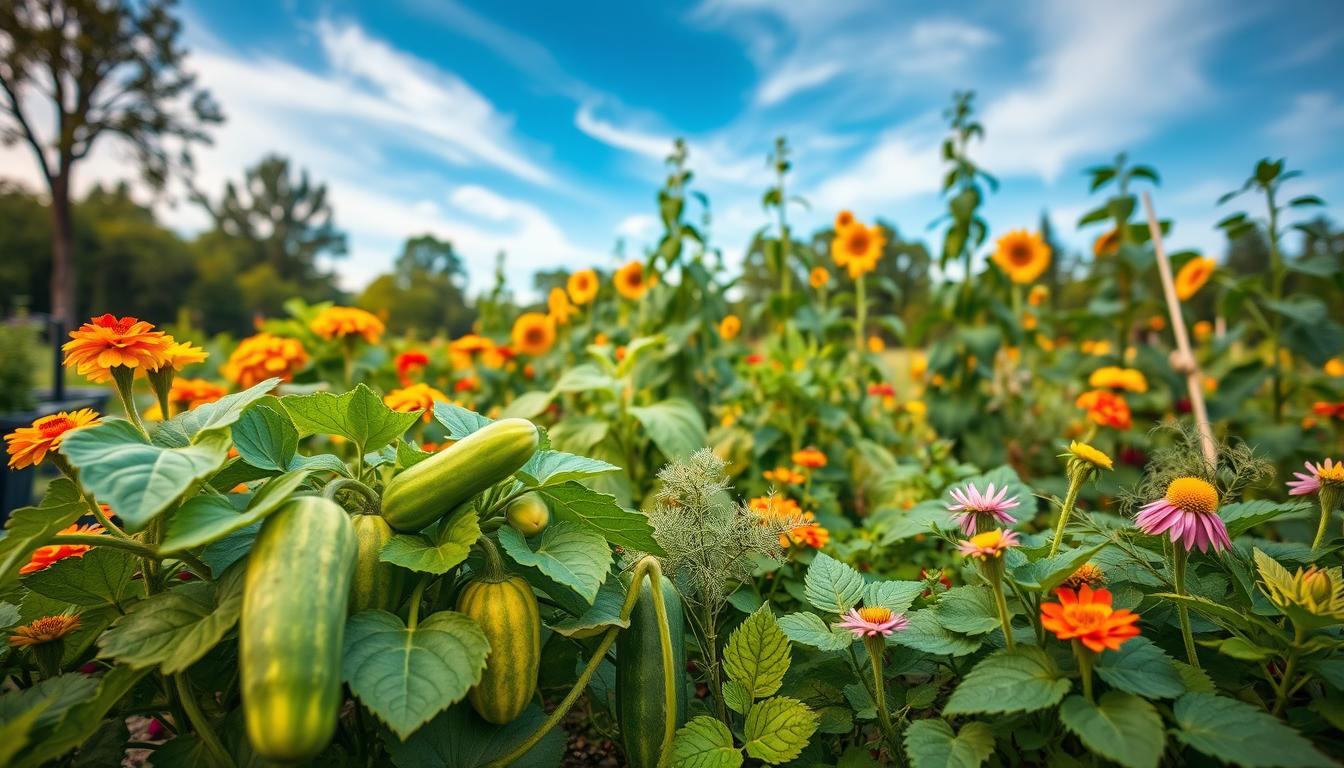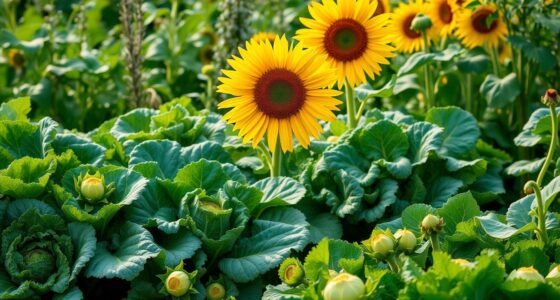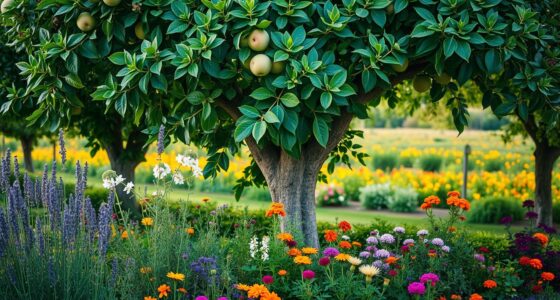Gardening is more than just planting seeds; it’s about cultivating a thriving ecosystem that flourishes with each passing season. When you plant cucumbers, you might find yourself captivated by their fresh, crisp taste and vibrant green vines. But have you ever considered how companion plants for cucumbers can elevate this experience? Pairing your cucumbers with the right neighbors can yield not just a bountiful harvest but also a garden teeming with life and color. This guide aims to enlighten you about the best companion plants for cucumbers and how these botanical friendships can enhance growth, ward off pests, and enrich your soil health. Whether you’re a seasoned gardener or just starting your green journey, discovering cucumber companion plants can transform your gardening endeavors into fruitful adventures.
Key Takeaways
- Understanding companion plants can greatly enhance your cucumber yield.
- Cucumber companion plants can help with pest control and soil health.
- Choosing the right plants can create a vibrant garden ecosystem.
- Some plants may hinder cucumber growth; knowing these is essential.
- Effective pairing includes herbs, flowers, and vegetables.
Why Companion Planting is Beneficial for Cucumbers
Engaging in companion planting can provide various advantages for growing cucumbers. This method pairs compatible plants to enhance overall garden performance. By leveraging the natural relationships between plants, you can experience significant benefits of companion planting that directly impact cucumber growth and yield. Let’s delve into a few key advantages.
Enhancing Growth and Yield
Cucumbers thrive when planted alongside supportive neighbors. For instance, when you plant cucumbers with nitrogen-fixing legumes like beans, the nitrogen released can lead to impressive growth and yield. A strategic pairing not only maximizes your harvest but also reduces the need for synthetic fertilizers.
Pest Control Advantages
Companion planting serves as an effective strategy for pest management. Certain plants can naturally repel pests that often target cucumbers, such as cucumber beetles and aphids. By including these companion plants in your garden, you can create a protective barrier that keeps harmful insects at bay, allowing your cucumbers to flourish.
Promoting Soil Health
One of the critical soil health benefits of companion planting lies in its capacity to improve soil structure and nutrient availability. Diverse root systems can aerate the soil, while some plants enhance microbial activity. This leads to healthier soils, providing a fertile ground for cucumbers and other vegetables to grow. A robust ecosystem nurtures plants, leading to increased resilience and productivity.
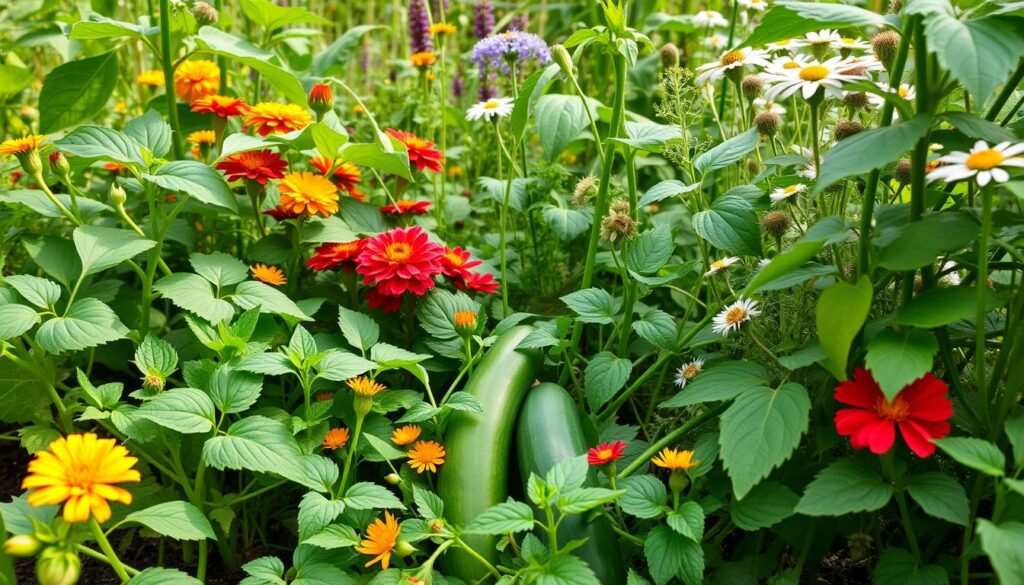
Ideal Companion Plants for Cucumbers
Cucumbers thrive best when surrounded by certain plants that support their growth and health. Choosing the right companions enhances not only the yield but also the overall vigor of your cucumber plants. Here are some of the ideal cucumber companions you may want to consider for a thriving garden.
Marigolds
Marigolds rank among the best plants for cucumbers due to their ability to deter various pests such as aphids and cucumber beetles. These vibrant flowers exude compounds that repel harmful insects, allowing your cucumbers to grow unhindered. Planting marigolds alongside cucumbers creates a natural barrier, enhancing the health of your vegetable garden.
Nasturtiums
Nasturtiums serve as excellent supporting plants for cucumbers. They attract beneficial insects, including pollinators like bees, while acting as a trap crop for aphids that would otherwise target cucumbers. By drawing these pests away, nasturtiums help protect your cucumber crop, making them an indispensable companion.
Borage
Borage is another fantastic addition to your garden, boosting the companionship of cucumbers. This herb encourages pollinator activity, providing a friendly environment for flowering plants. Borage also contributes trace minerals to the soil, enriching the earth around your cucumbers. By incorporating borage into your garden layout, you create a nurturing habitat for your cucumber plants.
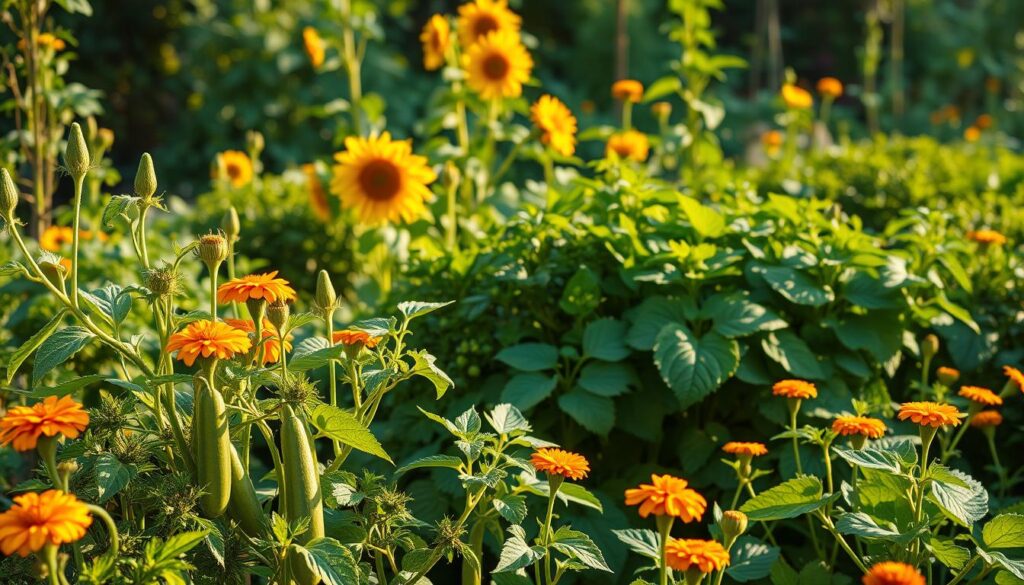
Plants to Avoid Near Cucumbers
When planning your cucumber garden, it’s essential to consider the plants to avoid with cucumbers. Certain plants can hinder growth or attract pests, creating issues in your garden. Knowing these incompatible cucumber companions can enhance your overall yield and plant health.
Potatoes
Potatoes are heavy feeders and compete aggressively for nutrients and water. This competition can significantly impact your cucumbers, leading to reduced yields and slower growth. It’s wise to keep these crops separated to ensure your cucumbers thrive.
Sage
The strong aroma of sage can be detrimental to cucumber growth. Its presence may stunt the development of cucumbers and adversely affect their flavor. Avoid planting these two varieties near each other for better results.
Melons
Melons and cucumbers share similar growth habits, making them incompatible cucumber companions. They not only compete for resources but also attract the same pests, increasing the risk of disease transfer. Keeping melons away from your cucumbers will help maintain a healthy garden.

How to Pair Companion Plants with Cucumbers
Successfully pairing companion plants with cucumbers requires thoughtful consideration of various factors. One crucial element to keep in mind is the planting schedules for cucumbers, as this ensures that your chosen companions will thrive alongside your cucumbers. Timing is essential for creating a harmonious garden environment that promotes optimal growth.
Consider Planting Schedules
Understanding planting schedules for cucumbers helps you determine the best time to introduce companion plants. Some plants thrive in the same season, while others may better support your cucumbers when staggered. For instance, you might plant early-blooming flowers that attract beneficial insects at the same time as your cucumbers to maximize their growth period.
Spacing and Placement Tips
Proper spacing is vital when interplanting cucumbers with companion plants. Make sure to provide enough distance between the cucumber plants and their companions to prevent overcrowding. Adequate spacing ensures that all plants receive sufficient sunlight and water, leading to healthier produce. A well-organized layout allows each plant to flourish in its own space.
Companion Planting Techniques
Employing techniques such as interplanting cucumbers with compatible companion plants can enhance your garden’s productivity. For example, planting low-growing plants like basil or marigolds alongside taller cucumbers can create a diverse planting scheme that maximizes available sunlight. Observing the growth habits of both cucumbers and their companions will guide you in achieving this balance effectively.
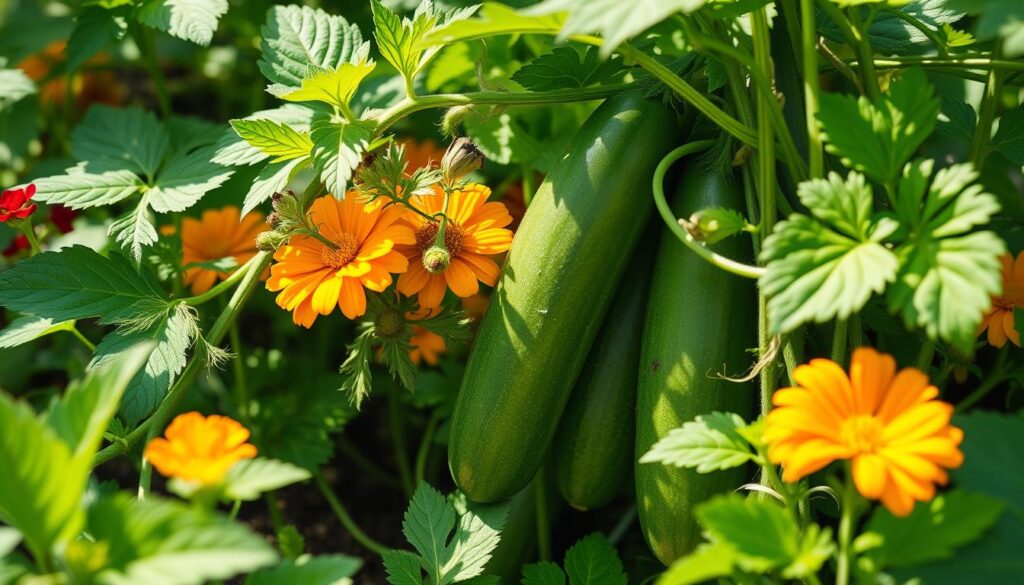
The Best Herbs to Plant with Cucumbers
Incorporating herbs into your cucumber garden can yield fantastic results. The best herbs for cucumbers not only enhance their flavor but also contribute to a healthier growing environment. Choosing the right herb companions for cucumbers boosts pest resistance and increases the overall yield of your crop.
Basil
Basil is a standout choice among the best herbs for cucumbers. Its robust aroma deters pests that threaten your plants while simultaneously enhancing the flavor of cucumbers. Growing basil close to your cucumber plants creates a mutually beneficial relationship, adding to your garden’s appeal and utility.
Dill
Dill serves as a remarkable herb companion for cucumbers. This herb attracts beneficial insects, such as predatory wasps and ladybugs, alleviating the cucumber pest problem. Additionally, dill contributes to improved yield, making it an ideal companion in your garden layout.
Cilantro
Cilantro is another excellent option for enhancing your cucumber plants. By luring ladybugs and lacewings, it effectively controls aphid populations that commonly affect cucumbers. Integrating cilantro into your planting scheme not only boosts pest management efforts but also adds a delightful flavor to your meals.
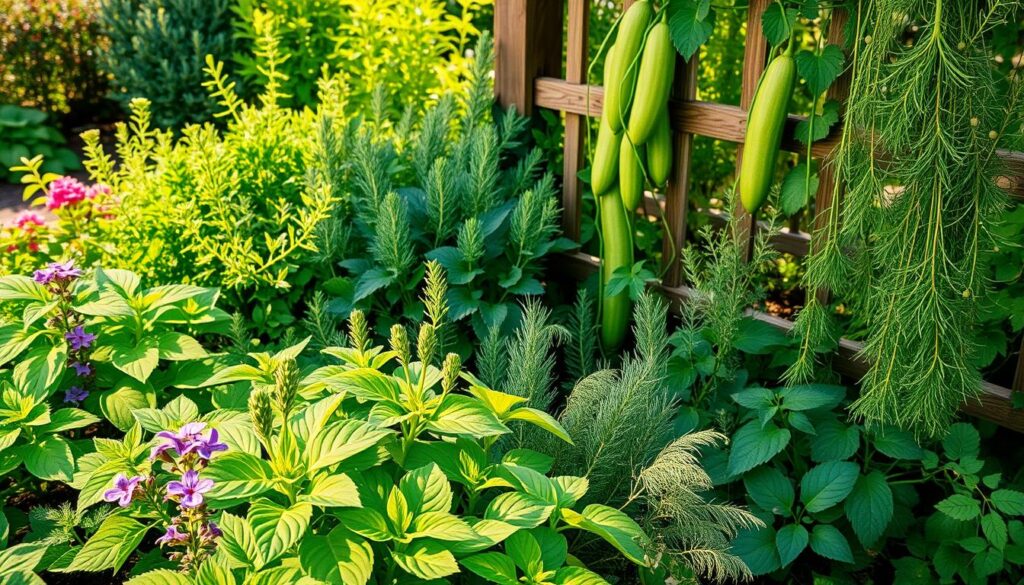
Flowering Plants that Help Cucumbers Thrive
In the pursuit of a successful cucumber harvest, incorporating flowering plants can significantly enhance your garden’s productivity. These vibrant blooms not only bring beauty but also serve essential roles in attracting beneficial insects and providing necessary support to your cucumbers. By adding these flowering plants for cucumbers to your garden, you create a thriving ecosystem that promotes pollination and pest control.
Sunflowers
Sunflowers are not only striking but can act as natural trellises for your cucumber vines. Their tall stature provides shade, helping cucumbers withstand periods of intense heat. The large blooms attract a variety of pollinators, enhancing the overall pollination of your vegetable garden, ensuring more robust yields.
Zinnias
Zinnias are vibrant and easy to grow, making them excellent supporting flowers for vegetable gardens. Their colorful blooms attract bees and butterflies, vital pollinators that help increase your cucumber yields. In addition, these flowers can deter some common pests, creating a healthier environment for your cucumbers.
Cosmos
Cosmos stand out with their delicate flowers and resilience in various growing conditions. They serve as great companions for cucumbers by attracting beneficial insects like ladybugs and lacewings, which aid in pest control. Incorporating cosmos into your garden can lead to a flourishing ecosystem, ultimately benefiting your vegetable crops.
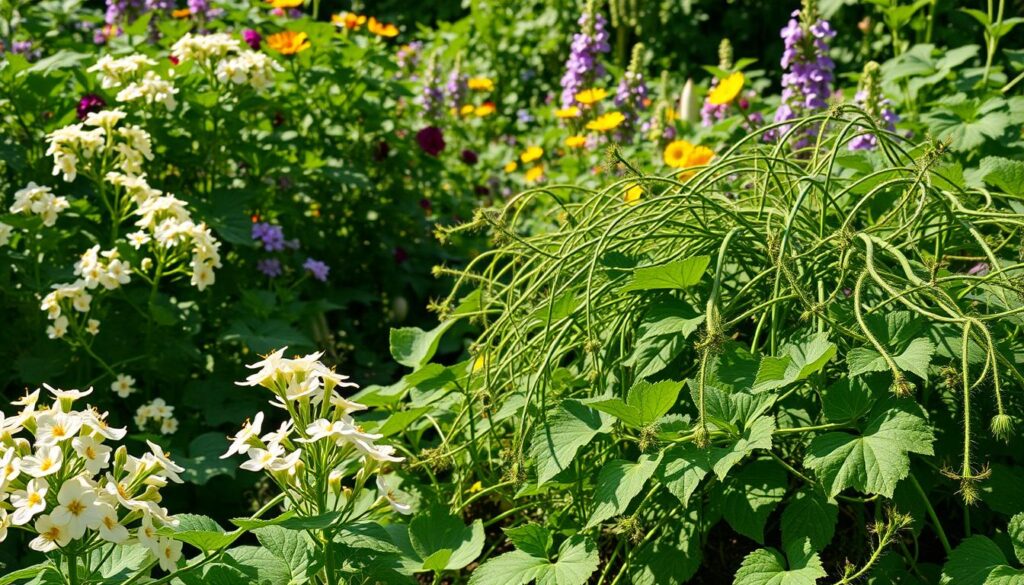
| Flowering Plant | Benefits | Ideal Growing Conditions |
|---|---|---|
| Sunflowers | Natural trellis, attracts pollinators | Full sun, well-drained soil |
| Zinnias | Attracts bees and butterflies, repels pests | Full sun, tolerates poor soil |
| Cosmos | Attracts beneficial insects, helps with pest control | Full sun, drought-tolerant |
By incorporating these flowering plants into your garden, you create a supportive environment for your cucumbers to thrive, optimizing both yield and health.
Benefits of Growing Companion Plants
The advantages of companion plants extend well beyond mere pest management. You can attract beneficial insects, helping to create a natural equilibrium in your garden. This reduced reliance on chemical pesticides can lead to healthier crops and a more sustainable environment.
Attracting Beneficial Insects
When you integrate companion plants, you create a welcoming habitat for pollinators and predatory insects. These beneficial creatures can help control pest populations and enhance your garden’s overall productivity. By fostering a diverse community of insects, your garden thrives naturally, showcasing one of the prominent advantages of companion plants.
Building Biodiversity
Biodiversity in gardening plays a crucial role in creating a resilient ecosystem. Companion planting introduces various species that reinforce your garden against pests and diseases. Increased biodiversity not only improves plant health but also ensures a robust garden that can withstand environmental stresses.
Improving Aesthetic Appeal
Partnering plants can transform your garden’s visual landscape. By selecting companion plants with contrasting colors and textures, you can enhance the beauty of your outdoor space. The visual benefits of companion planting are significant, as a diverse garden design not only pleases the eye but maximizes available space efficiently.
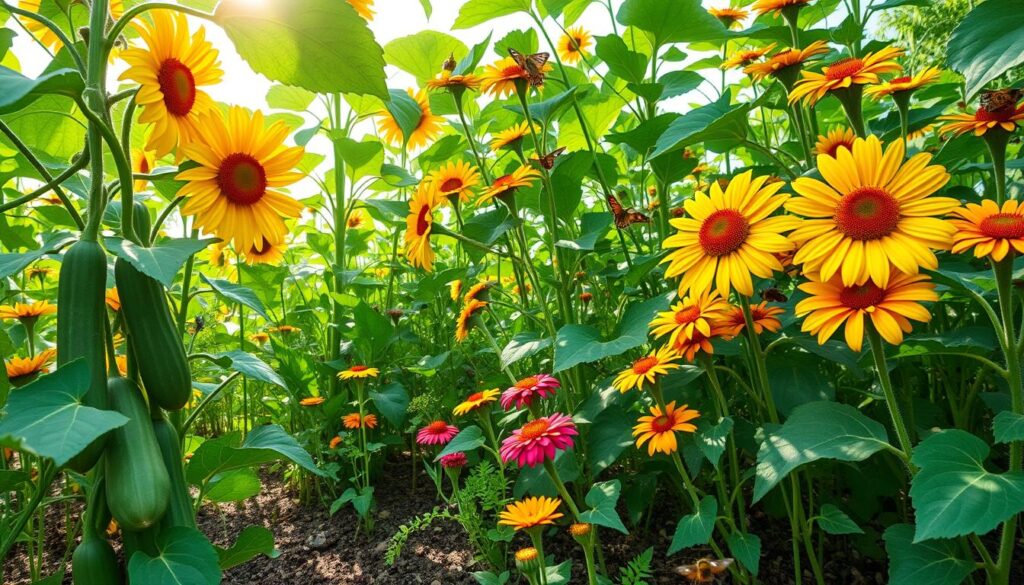
Seasonal Companion Planting for Cucumbers
Understanding the timing of seasonal planting with cucumbers is crucial to a successful garden. Each planting season brings unique opportunities for pairing cucumbers with compatible plants that enhance their growth and yield. To maximize the benefits of companion planting, explore these strategies for spring, summer, and fall.
Spring Planting Strategies
As spring emerges, it’s ideal to introduce cold-tolerant crops. Consider integrating some of these spring companion plants:
- Lettuce
- Radishes
- Peas
These plants establish quickly and can coexist with cucumbers, providing shade and conserving soil moisture. Their growth early in the season allows for a fruitful garden layout.
Summer Planting Suggestions
In summer, the heat rises, creating a perfect environment for heat-loving plants. Some excellent companions during this season include:
- Basil
- Zinnias
- Nasturtiums
These summer companions not only thrive alongside cucumbers but can also attract pollinators, further improving your garden’s productivity. The lush foliage of these plants helps provide shade, reducing water loss in the soil.
Fall Companion Options
As the seasons transition, it’s essential to prepare for a successful fall. Crops like garlic make for excellent companions during fall planting. Here’s why:
- Requires less water compared to cucumbers
- Harvested before winter
- Frees up space for late-season cucumbers to develop
By implementing these summer and fall planting tips, you can ensure continued success in your companion planting journey.
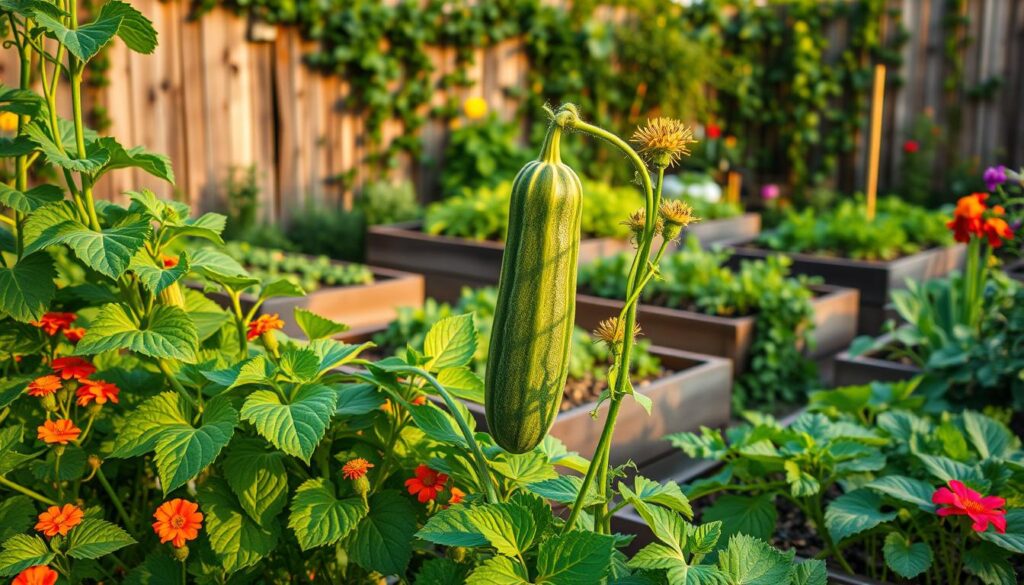
Companion Planting and Crop Rotation
Integrating companion planting with crop rotation is essential for achieving the best results in your garden. Understanding the importance of crop rotation can help you maintain soil health and maximize your yields while promoting sustainable gardening practices. By rotating companion plants, you can effectively combat pests and enhance soil fertility.
Importance of Crop Rotation
Crop rotation beneficially alters the planting schedule each year, preventing the depletion of crucial nutrients in the soil. This practice reduces the risk of specific pests and diseases that thrive on particular plant families. Regularly shifting your plant selection allows the soil to recover and brings different nutrients back into play, supporting healthier plants in the long term.
How to Rotate Companion Plants
When rotating companion plants, consider the compatible pairs that work well together. Here are some key tips to follow:
- Change plant families seasonally to minimize the buildup of pests.
- Incorporate legumes to fix nitrogen back into the soil, enhancing fertility for subsequent crops.
- Utilize rotating companion plants alongside traditional crop rotation for a holistic approach.
Long-term Benefits
Engaging in crop rotation and rotating companion plants leads to numerous long-term benefits. It not only improves your soil structure and health but also contributes to sustainable gardening practices that can reduce the need for chemical fertilizers. Embracing these strategies creates a thriving garden environment that supports biodiversity and ensures productive harvests year after year.

Organic Practices for Companion Planting
Incorporating organic practices into your companion planting strategy promotes a thriving and sustainable gardening experience. By focusing on natural methods, you can enjoy the benefits of enriching soil naturally while ensuring healthy crops. Implementing effective techniques in your garden contributes to a robust ecosystem and minimizes environmental impact.
Natural Pest Management
Utilizing companion plants allows you to address pest issues without relying on chemical pesticides, making way for sustainable pest control. Certain plants naturally repel insects or attract beneficial ones, helping you manage pests effectively. Examples of pest-repelling companion plants include marigolds and nasturtiums, which deter harmful critters and create balance in your garden.
Soil Enrichment Techniques
Enriching soil naturally is another key aspect of organic companion planting. Techniques such as green manure and cover cropping provide essential nutrients while improving soil structure. For instance, incorporating legumes adds nitrogen to the soil, creating an ideal environment for cucumbers to flourish. This approach not only enhances soil fertility but also promotes a healthier garden overall.

Maximizing Your Garden Space with Companions
In the world of gardening, effective space management is essential for creating a flourishing environment. Techniques such as vertical gardening cucumbers help you to optimize limited areas while promoting healthier plant growth. By incorporating various space-saving techniques, you can increase your yield without overwhelming your garden space.
Vertical Gardening Techniques
Vertical gardening encourages the growth of cucumbers upward rather than outward. Utilizing trellises and support systems allows cucumbers to climb, maximizing vertical space while enhancing air circulation around the plants. This approach not only saves ground area but also minimizes the risk of diseases caused by overcrowding. You can create an aesthetically pleasing garden while ensuring your plants receive adequate sunlight and nutrition.
Interplanting Strategies
Interplanting for yield is another effective method to make the most of your gardening space. By strategically placing plants with varying heights and root depths, you can minimize competition for resources. For instance, pairing low-growing herbs or flowers with climbing cucumbers provides a balanced ecosystem. This not only enhances productivity but also creates a diverse garden that can better withstand pests and diseases.
| Technique | Description | Benefits |
|---|---|---|
| Vertical Gardening | Using trellises or structures for climbing plants | Maximizes utilization of vertical space, ensures better air circulation |
| Interplanting | Mixing plants with varying heights in the same area | Reduces competition for sunlight and nutrients, increases overall yield |
| Companion Planting | Planting complementary species together | Enhances growth, deters pests, improves biodiversity |
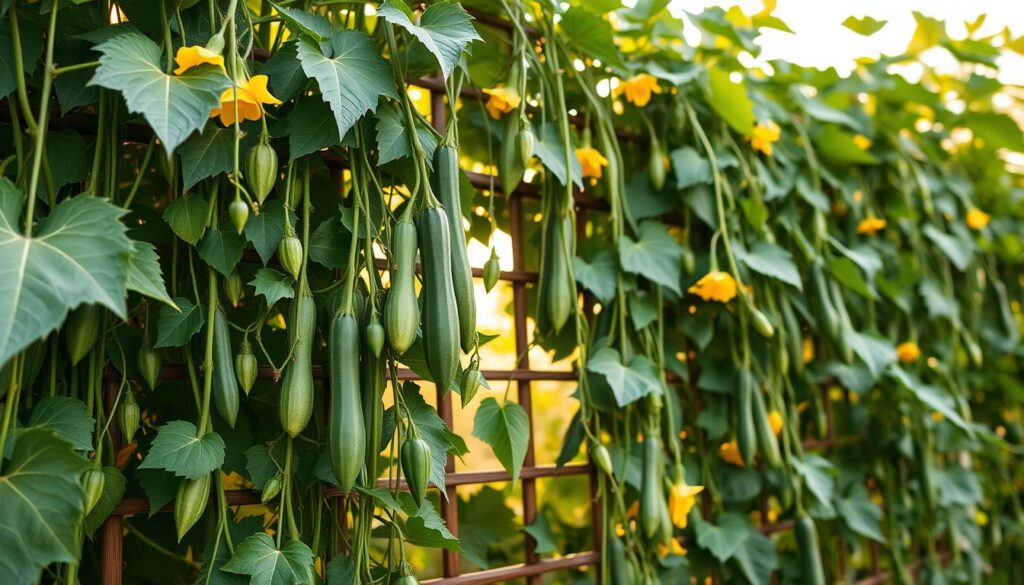
Common Questions About Companion Plants
Understanding companion plants can improve your gardening experience. Many gardeners have common inquiries about which plants pair best, their spacing needs, and effective incorporation methods. Addressing these companion planting FAQs can enhance your yields and overall garden health.
What are the Best Companion Plants?
Choosing the right companion plants, such as marigolds and nasturtiums, is crucial for a thriving cucumber garden. These plants naturally protect against pests and help improve growth. Researching the characteristics of various plants will aid your decision-making in incorporating companion plants effectively.
How Close Should They Be Planted?
Understanding adequate planting distances is essential. Keeping companion plants at appropriate distances prevents overcrowding and ensures that each plant receives sufficient sunlight and nutrients. The ideal spacing can vary, so consider the specific needs of your selected companions.
How do I Incorporate Them in My Garden?
Incorporating companion plants into your garden involves planning and research. Start by mapping out your garden layout during the planting phase. Pay attention to the growth habits of each plant to ensure they coexist harmoniously. By methodically incorporating companion plants, you enhance the health and productivity of your garden.
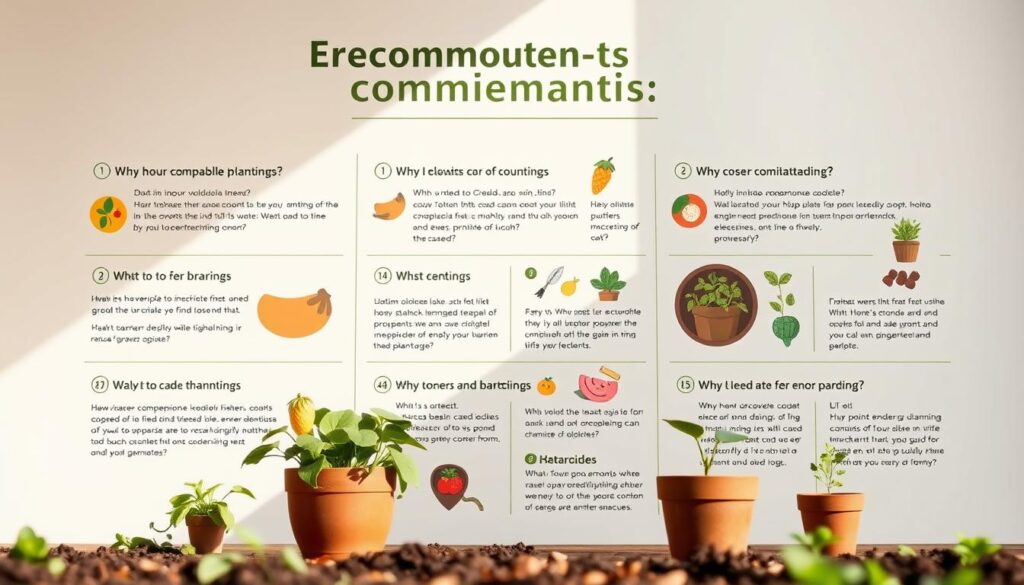
Real-Life Success Stories from Cucumbers’ Companions
Many gardeners have shared their cucumber gardening success stories, showcasing the benefits of companion planting through various experiences. Home gardeners report improved yields and healthier plants when they integrate specific companions into their cucumber plots. These personal accounts offer valuable insights.
Testimonials from Home Gardeners
Home gardeners often highlight the effectiveness of combining cucumbers with marigolds and borage. One gardener shared, “After planting marigolds alongside my cucumbers, I noticed a significant decrease in pest activity. This pairing not only protected my cucumbers but also enhanced their growth.” Another testimonial emphasized how dill improved the overall vitality of their cucumber plants, stating, “Cucumbers flourished when planted with dill. The plants appeared more robust and produced better fruit.”
Case Studies from Community Gardens
Community garden experiences further validate the benefits of companion planting. In a local community garden, plots featuring sunflowers alongside cucumbers thrived beyond expectations. Gardeners documented an impressive increase in cucumber yield and a more vibrant ecosystem. They shared, “Before we paired sunflowers, our cucumbers struggled. Now, they not only look fantastic but produce abundantly.” Such observations illustrate the transformative power of thoughtful plant pairings in community settings.
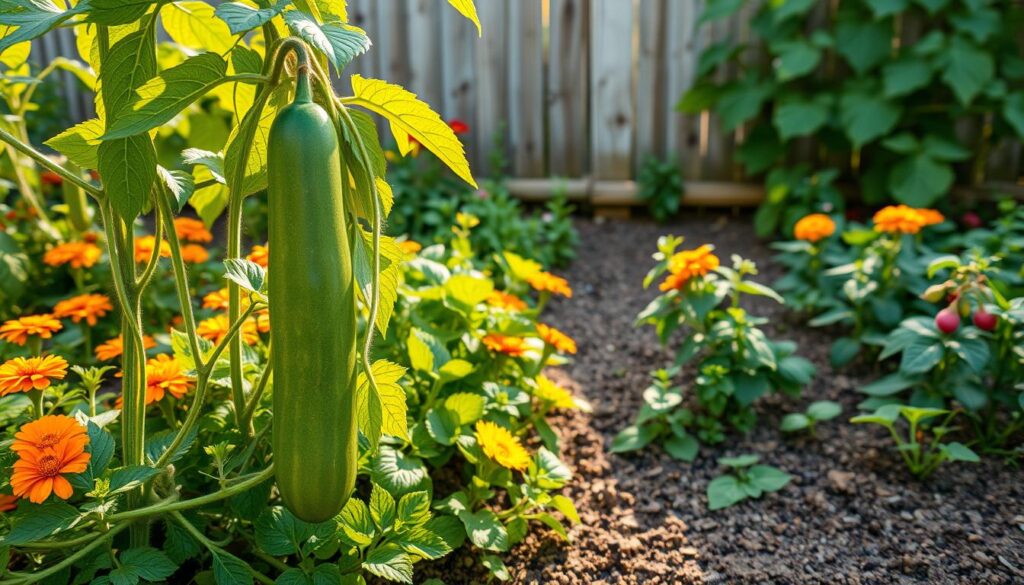
| Companion Plant | Benefit | Gardener’s Observations |
|---|---|---|
| Marigolds | Pest control | Significant reduction in pest activity. |
| Borage | Growth boost | Cucumbers showed increased vigor. |
| Dill | Healthier plants | Cucumbers produced larger fruit. |
| Sunflowers | Enhanced yields | Notable increase in cucumber production. |
Tips for Successful Companion Planting
Embarking on a journey of companion planting can significantly enhance your gardening experience, especially with cucumbers. As you navigate through this rewarding process, it’s essential to utilize helpful gardening resources, including planting guides and companion planting charts, to identify optimal plant pairings. These tools can serve as your roadmap, ensuring you make informed decisions that will result in a flourishing garden.
While exploring the world of companion plants, it’s important to keep several common mistakes in mind. Avoiding planting mistakes such as improper spacing and overlooking plant incompatibilities can make a distinction in your gardening success. Additionally, planning for crop rotation is crucial for maintaining soil health and maximizing overall productivity. By keeping these factors in mind, you can create a vibrant and harmonious garden environment.
To ensure that your plants thrive together, prioritize regular observation and consistent maintenance. By monitoring plant health and promptly addressing any issues, you’ll nurture a vibrant ecosystem in your garden. This dedication not only fosters strong plant relationships but also enhances your overall gardening experience, leading to a bountiful harvest and vibrant displays of growth.
